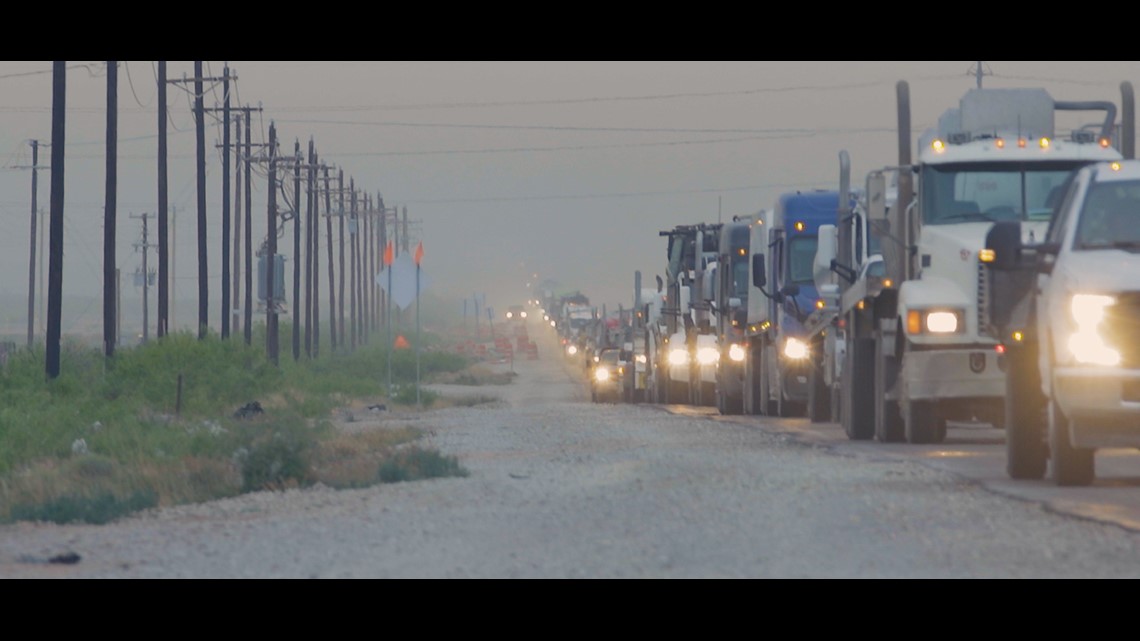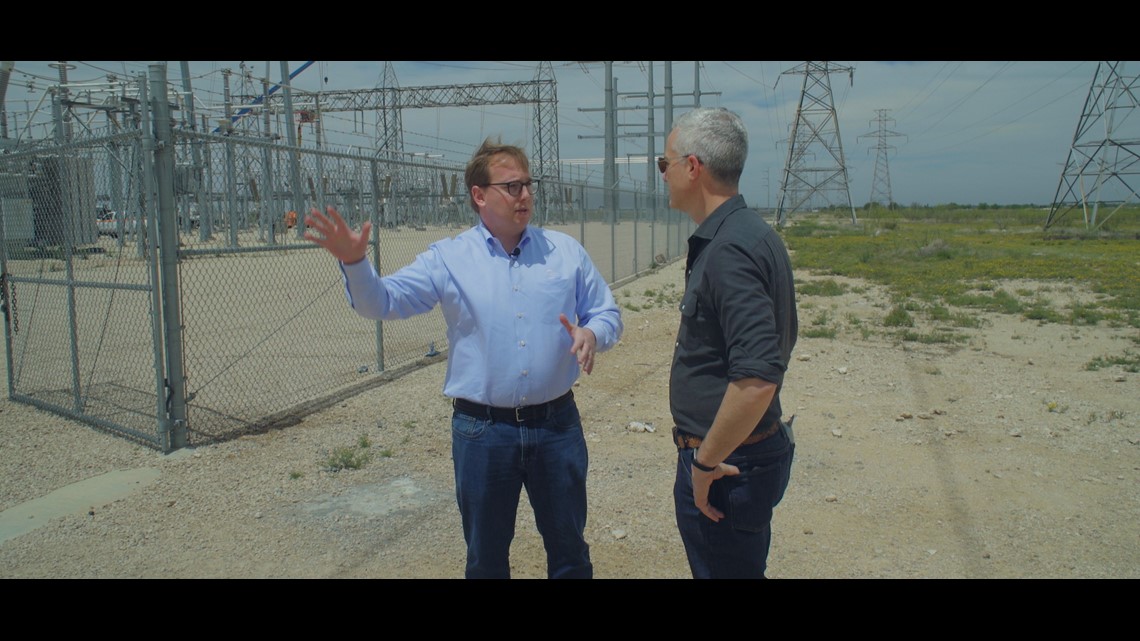PECOS, Texas — Welcome to the Permian Basin, six hours west of Dallas.
Compared to the last West Texas oil boom in 2014, there's almost four times more oil flowing in the Permian Basin.
Oil and gas companies have turned this dusty, desert landscape into a heavy industrial zone. Small towns, once sleepy, are now exploding. The pace is so frantic, I want to know if Texas has the infrastructure and resources to keep this up?


LEAVING PECOS
It’s 5:30am, in Pecos, Texas, and I’m meeting up with Jesse Lane. He’s been working in the West Texas oil field for two years as the operations manager of Nimble Crane.
“Anything heavy that needs to be moved in the Permian Basin, we pick it up,” he tells me.
“Which is a lot of stuff out here?” I ask.
“Everything,” he says.
Most of the guys out here work 21 days with seven days off. It’s common to clock 100-hour work weeks. Workers live in pop-up trailer parks or portable motels called "man camps."
Jesse told me I wouldn't believe what's going on unless I saw it for myself. So I came. We started our tour by checking out a few gas stations in town where heavy trucks are lined up to get fuel.
“So, it's 5:45 in the morning and look at the line to get fuel. In this little town where there should be nothing going on,” Jesse says.
We’re making our way west, from Pecos to the town of Orla, deeper into the oil fields. We make a left turn onto a highway that’s jammed with oversized trucks.
“Left turn into traffic. Wrong time of day,” Jesse tells me as we wait. “Everybody right with Jesus? It’s the wild west, man,” Jesse says.
As the sun rises, traffic on the two-lane highway is completely stopped. We’re a half-mile from Orla, population 56. There’s a four-way stop in town and hundreds of heavy trucks all need to squeeze through.


“How long will this take us to get to Orla,” I ask.
“About an hour,” he says of the half-mile traffic jam.
“What's the situation with the roads?” I ask.
“Roads are horrible. Everything you see out here is heavy. Trucks are easily 80,000 pounds,” Jesse says. “Too many trucks the roads aren't designed for it,” he adds.
“Why did you want us to come out here?” I say to Jesse.
“I wanted you to see this mess. I wanted you to see the miles of traffic that back up. It's miserable. But if you have a pulse you can make $100,000. So, naturally, we're here,” Jesse tells me.
THE ROADS
John Speed runs this region for the Texas Department of Transportation.
“The area here in Pecos is traffic jams out the wazoo,” Speed says. “That is a very small community that has exploded. No one was expecting oil out here."
Speed says that innovation in the fracking process is why there are so many trucks out here.
During the last boom, horizontal drilling went out about a half mile. Today, with advances in technology, crews can drill out two miles and beyond.
That requires far more of the resources essential to fracking -- water and sand.
“The amount of material that has to be moved is vastly different than just a few years ago,” Speed says. “Those surfaces are deteriorating at a much faster rate than we'd like to see them deteriorate."
Fixing the roads comes at a cost. The Permian Basin now uses 10-times more of the state's highway funds than it used to.
“Is TxDOT's role to enable this boom and expansion to keep going?” I ask.
“Yes. It's one of them,” Speed says. “We're trying to keep those roads up, so they can have a reliable source of that material at the well site when they need it.”
ELECTRICITY
Crumbling roads aren't Jesse's only problems out here. It takes a lot of power to make oil and gas.
“There's not enough electricity out here. We have power outages left and right because of the draw. It's much worse in the summer too. You have rolling blackouts. Lots of times when it's 100 degrees but you have no air conditioner in the place that you're staying,” he says.
The agency that runs Texas' power grid, ERCOT, is warning about "significant oil and gas development in far West Texas…" And that’s one reason, on the hottest summer days, the system will feel more strain.
To learn more, I went to see Geoff Bailey, with Oncor, the company that delivers electricity. We’re touring some of the company’s West Texas infrastructure. He says, in some places, Oncor has seen a 400 percent increase in demand for power.


“Were you ready for a 400 percent increased demand?” I ask him.
“From 2014 to 2018, the past four or five years, Oncor invested $1.6 billion in West Texas in infrastructure just like this,” Geoff says.
He says Oncor is spending that money because it's confident that low oil prices will not be as damaging to the Permian Basin as they used to be.
The break-even price of oil is the lowest price before you start losing money. According to an analysis by Rystad Energy in 2014, the average break-even price was $96 dollars a barrel. Today, the break-even is down to $45, meaning the Permian Basin can survive lower prices.
“We're putting this infrastructure in place not just to meet the demand of the next few years but to meet the demand of the next generation,” Geoff says.
WATER
About 50 minutes south is the town of Balmorhea, home to the world's largest spring-fed swimming pool. The 85-year-old pool is bigger than an acre and full of fish. From here you can see the Davis Mountains.
The same desert spring water that feeds the pool also fills the Lake Balmorhea reservoir and supports the people and agriculture through a system of canals.
I’m riding around the area with JD Newsom, Executive Director of the Big Bend Conservation Alliance. He’s an advocate for protecting and preserving the way of life in far West Texas.
“Balmorhea is something that people know around Texas because they've been here, and they love it,” I say.
“It's a true treasure of West Texas,” JD says.
“Do you feel like there is some threat to its future?” I ask.
“It's certainly a concern of ours. The faster the water depletes the most risk these spring systems face,” he tells me.


A study from Duke University found that it takes 11 million gallons of water to frack one well in the Permian Basin, and the demand for water to drill here is up to a 770 percent.
When it comes to water, Texas follows the “rule of capture." Basically, that means you have the right to pump and use any water under your property.
According to Texas A&M University, “Texas courts have consistently ruled that a landowner has a right to pump all the water that he can from beneath his land regardless of the effect on wells of adjacent owners.”
“When the water's right here, realistically this is the first place you're going to go to try and get the water, right?” I ask JD.
“In order for us to better manage the water we're going to have to have some different policies in effect,” he says.
“Doesn't that get in the way of?” I ask, as JD finishes my sentence.
“Progress and development? Sure,” he says.
“Pecos and the areas around there are booming. Boom towns. Do you want to stop that industrialization from coming here?” I ask.
“I don’t think that's the answer. And would be a naïve way to look at it. It's not a matter of if but when. I don't think it should be just a one-sided conversation that we have to have progress and development and we have to extract oil and gas. We need to be having the conversation about what's important for us,” he adds.
CONCLUSION
So, we've seen people are willing to work for high salaries but low quality of life. The roads are bad but getting better. Electricity is tight, but more is coming. And drilling keeps getting more efficient.
Can the infrastructure in Texas keep up this growth? Yes.
But I think we have to keep JD’s questions in mind… can we find ways to do all this and still leave the best of Texas for the next generation.
Got something you want verified, send me an email: david@verifytv.com

